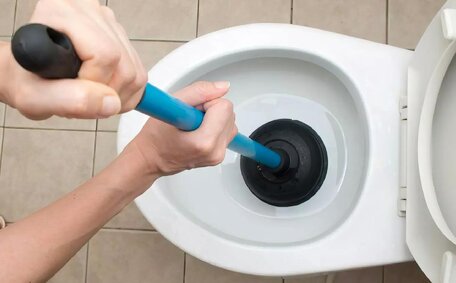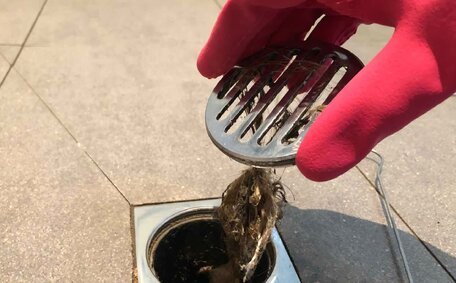
How to Prevent Household Blocked Drains
Blocked drains can be prevented by using drain strainers, avoiding pouring oils down drains, clearing hair from drains, and more tips from Seven Hills Plumbing.
Read MorePipes tend to freeze when temperatures drop to -6 degrees Celsius or below. Upon reaching this cold threshold, liquid water within your water pipes begins its transition into ice and swelling, inciting pressure accumulation. The freezing process transforms liquid into ice, blocking the pipe’s passage.
Numerous factors, including insufficient insulation around pipes, contribute to the likelihood of them freezing:
The terms and conditions under which indoor supply lines and outdoor hose bibs can fall prey to freezing, confirm the vulnerabilities across a myriad of locations. Residents in cooler areas, like Seven Hills, need to insulate their pipes to reduce the risk of them freezing.
Freezing temperatures cause water inside your water pipe to expand as it turns to ice.
Ice expansion increases water volume by about 9%, potentially leading to extreme pressure and the possibility of pipe rupture. Such expansion from fluid to solid can exert substantial water pressure upon the pipe walls, a significant factor that may result in pipe failure. The force exerted by expanding ice within a pipe can cause extensive damage including cracks, bursts, or ruptures.
If a pipe bursts due to freezing, water starts escaping through the openings formed. Frozen and burst pipes can lead to significant water damage as leaks affect walls, ceilings, and other areas of the home. Valuable items can be destroyed and structural issues may develop from chronic moisture exposure due to water can inundate supply line spills.
A frozen pipe can compromise structural integrity significantly, also severing the water supply until repairs are complete. A burst pipe can disrupt access to running water for all essential household activities. Timely repairs are critical to avoid the complications associated with a lack of water during freezing conditions.
Taking early steps to protect against freezing is essential in preventing pipe freeze. To stop your pipes from yielding to the freeze, ensure they’re insulated properly, which includes opening cabinet doors to promote heat circulation.
Connect with Seven Hills Plumbing if you find your pipes frozen; quick action to address such issues is pivotal. Our licenced technicians serve Seven Hills, Sydney and can assess your pipes and prevent severe damage this winter.
Pipes located along an exterior wall or in unheated areas of a home are often most prone to freezing. Frequent risk areas outside your direct living quarters encompass basements, crawl spaces, and more:
Outdoor fixtures such as your outdoor hose bib and irrigation systems, though likely to freeze, can be safeguarded with proper precautions, making them resistant to cold. In the Seven Hills region, winter temperatures can fall below freezing, with overnight lows dipping under 3°C. Homeowners should thoroughly inspect any pipes water passes through, especially those in unheated areas, to identify and address weak points.
An annual pre-winter review can make a significant difference for the pipes your home relies on, permitting preemptive insulation or heating upgrades to risk-prone plumbing. A qualified Seven Hills plumber can inspect your property to identify and address potential issues.
The material pipes are made from impacts how quickly they may freeze and their likelihood of bursting:
Diligent insulation practices are key in helping protect your pipes from the brunt of the chill, preventing them from freezing. Insulate pipes to help them maintain heat, fortifying them against low temperatures and reducing the likelihood of freezing.
Common insulation materials like foam, heat tape, fibreglass, or rubber tubing act as a temperature barrier for your water supply lines. The various areas your home encompasses, such as attics, under-house crawl spaces, and garages gain immense benefit from the insulation of pipes or supply lines traversing them.
Outdoor faucets and irrigation lines situated near water supplies must have shutoff valves to halt the flow through the drain line and thwart freezing. These installations enable homeowners to shut off water lines and either drain or further insulate them when inactive during winter months. Examine insulation around pipes on exterior walls as cold air may seep in through these points.
Keep your thermostat at a steady warm setting to prevent frost affecting your pipes and taps. We recommend keeping your thermostat consistently set to a minimum of 55°F (13°C) during colder months.
Consistent thermostat settings reduce the risk of freezing and prevent significant temperature fluctuations. Sudden temperature drops heighten the risk of pipes freezing. Your heating strategy should encompass all areas with pipes, including the kitchen, bathroom, and basement.
Pay special attention to thermostat settings if your Seven Hills property will be vacant for a period of time. Aim to keep the temperature stable around 55-60°F (13-16°C). Also ensure even rarely used rooms with water pipes are adequately heated and insulated.
Maintaining a stable thermostat setting prevents frozen pipes and consumes less energy than reheating spaces that have cooled significantly. Automatically scheduled heating that doesn’t overly fluctuate offers the best protection.
At Seven Hills Plumbing, we offer locale-specific guidance that can shore up your plumbing against winter damage. Get in touch today if you have any queries or want to review your current home thermostat plan.
There are key measures you can undertake to prevent hardship should you find a pipe frozen during the cold season:
Preventing frozen pipes starts with properly insulating exposed pipes. Use specific pipe insulation wraps or heat cable to create a robust protective barrier.
Keep your thermostat set to at least 55°F throughout your home, even in unused rooms with pipes. Consistent indoor temperatures are crucial.
Allow faucets to drip slightly; this keeps water moving and helps prevent pipes from freezing during severe frosts.
Use weatherstripping and caulking to seal any cracks, gaps or openings that cold air could penetrate to reach water pipes.
Exercise caution to see that garden hoses and faucets are adequately purged, letting water drain thoroughly, and shut off so no water remains in the lines.
Be proactive before winter sets in, consult with our Seven Hills plumbers about an inspection or customised steps for your property to circumvent the complications of frozen pipes.
Discovering frozen pipes necessitates quick action, and mastering how to thaw frozen segments is essential to prevent extensive harm. Follow these steps:
Find the main water shutoff valve (usually near your water metre). Use the main shutoff to immediately isolate the water system if a pipe bursts.
Check all taps; limited or no flow indicates a likely freeze in the pipes.
Gently warm suspected frozen areas with a hair dryer set to a moderate temperature, avoiding the use of any open flame. Take utmost care to avoid overheating and damaging pipes, ensuring you eschew any open flame while thawing effectively.
If you spot sections with stagnant water, determine the freeze point by carefully applying heat to frozen parts of the pipe. Don’t leave taps open if water isn’t flowing.
If you’re unsure about the extent of pipe freezing or have any burst pipes, get professional assistance immediately by contacting our Seven Hills team to minimise further issues.
While addressing water pipes freezing yourself is an option, enlisting a licenced Seven Hills plumber guarantees it’s managed correctly. They can properly inspect for bursts and target the freeze using specialised methods.
Learning how to thaw one or more confirmed frozen pipes requires swift and cautious action. However, exercise caution as thawing too rapidly or unevenly can cause unseen cracks to burst. Consider contacting a professional Seven Hills plumber for safe pipe thawing services.
Using a hair dryer set to a warm setting serves as an effective DIY solution for thawing pipes frozen in hard-to-reach areas. Target the frozen section directly, keeping the dryer 6-12 inches away to prevent overheating. Gently move the dryer back and forth, ensuring all pipe sides receive even warmth.
Space heaters or heat lamps can assist in thawing, but it’s vital to position them so they don’t directly contact pipes. Monitor temperatures closely to maintain around 70°F maximum heat. Rotate lamps surrounding the frozen area for balanced, gradual thawing.
Wrap insulation such as heating pads or towels around pipes while applying heat to effectively thaw frozen areas. This contains warmth better to penetrate frozen areas faster. Ensure insulation never directly touches pipes to avert scalding risks.
As frozen sections melt and water starts to comes out, slightly open the nearest taps to alleviate pressure. This step relieves pressure from melting ice, reducing the risk of pipe bursts. Avoid leaving taps open without water flow, as this could allow pipes to refreeze.
Regularly check pipes during thawing to detect softened sections and the resumption of water flow. Isolate problem areas as able to pinpoint remaining frozen blocks. Partially thawed pipes remain vulnerable to freezing again quickly.
For professional pipe thawing in Seven Hills, Sydney, call our team any time on 1300 349 338. Allow our licenced technicians to safely inspect and restore your water supply.
Blocked drains can be prevented by using drain strainers, avoiding pouring oils down drains, clearing hair from drains, and more tips from Seven Hills Plumbing.
Read MoreNoticing signs of a household blocked drain like slow drainage, gurgling sounds, foul odours or overflowing water indicates you need an emergency plumber. Call Seven Hills Plumbing to dispatch a plumber to clear your blocked pipes before further damage.
Read MoreRestaurants and cafes frequently deal with blocked kitchen drains due to grease, fat and food buildup. Prevent clogged pipes through scraping plates, using drain strainers and avoiding pouring fats/oils down sinks. Or call a professional plumber to hydro jet pipes and permanently clear blockages.
Read MoreSeven Hills, 2147 NSW
We will call back as soon as possible.




